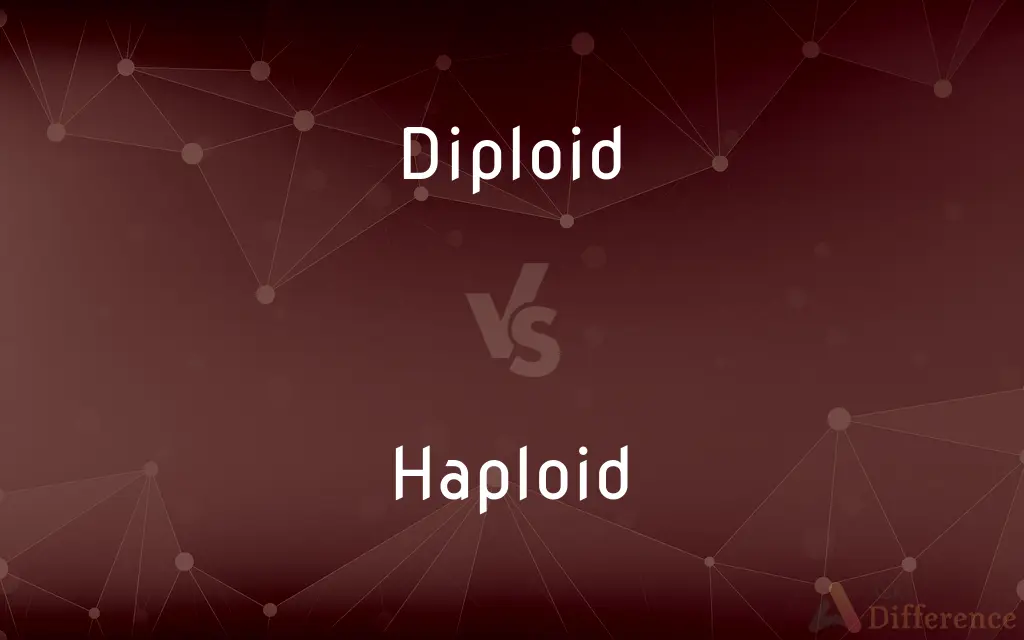Diploid vs. Haploid — What's the Difference?
By Tayyaba Rehman — Updated on November 6, 2023
Diploid cells contain two complete sets of chromosomes, while haploid cells have only one set.

Difference Between Diploid and Haploid
Table of Contents
ADVERTISEMENT
Key Differences
In the context of cellular biology, diploid and haploid refer to the number of chromosome sets found in the nucleus of a cell. Diploid cells, denoted as 2n, have two complete sets of chromosomes, one from each parent, and are typical of somatic cells in animals and plants. These cells are involved in mitosis, where they divide to produce genetically identical diploid cells. Haploid cells, on the other hand, contain one set of chromosomes (n) and are seen in the gametes of organisms. These cells are a result of meiosis, a type of cell division that reduces the chromosome number by half, resulting in the formation of gametes that can fuse during fertilization to form a diploid zygote.
The difference between diploid and haploid states is fundamental to genetic inheritance. In diploids, alleles for a gene can be homozygous or heterozygous, providing a basis for Mendelian inheritance and genetic variation. Haploids, however, have one allele for each gene, which simplifies inheritance patterns but also means that any genetic defects are immediately expressed.
Diploidy provides an advantage by masking deleterious alleles, while haploidy ensures that beneficial mutations are directly taken advantage of, as there is no second allele to mask their effect. The balance between diploid and haploid phases varies among organisms and is a crucial aspect of their evolutionary strategies for adapting to their environment.
Comparison Chart
Chromosome Sets
Two sets (2n), one from each parent.
One set (n), not paired.
Cell Type
Somatic cells, zygotes.
Gametes (sperm and eggs).
ADVERTISEMENT
Genetic Variation
Greater variation, two alleles per gene.
Less variation, one allele per gene.
Cell Division
Mitosis for growth and repair.
Meiosis for reproductive cells.
Organisms
Most animals and plants.
Some fungi, algae, and gametes.
Compare with Definitions
Diploid
Containing two complete sets of chromosomes.
Human body cells are diploid with 46 chromosomes.
Haploid
Containing a single set of chromosomes.
Gametes are haploid, carrying only 23 chromosomes in humans.
Diploid
Cells with paired chromosomes.
In diploid organisms, each parent contributes one set of chromosomes.
Haploid
Cells with unpaired chromosomes.
In the haploid phase of the life cycle, cells contain one allele for each gene.
Diploid
The normal chromosome complement.
Diploid cells undergo mitosis to create identical cells.
Haploid
Single allele per gene.
Any mutation in a haploid organism’s gene is immediately expressed.
Diploid
Typical of somatic cells.
Every diploid cell has a matching chromosome pair.
Haploid
Having a single set of unpaired chromosomes, as in a germ cell or in the somatic cells of a drone bee.
Diploid
Double or twofold.
Haploid
A haploid organism or cell.
Diploid
(Genetics) Having a pair of each type of chromosome in the cell nucleus, so that the basic chromosome number is doubled
Diploid somatic cells.
Haploid
(genetics) Having a single set of unpaired chromosomes.
Examples of haploid cells are prokaryotes and the gametes of eukaryotes.
Diploid
Double the haploid number.
Zygotes are diploid, thus restoring the chromosome number after fertilization.
Haploid
A cell which is haploid.
Diploid
A diploid organism or cell.
Haploid
An organism, such as a fungus, with haploid cells.
Diploid
(genetics) Of an organism, having diploid cells.
Haploid
Having half the number of chromosomes normally present in somatic cells; having only one chromosome of each type, and therefore having only one complete set of genes; Contrasted with diploid and polyploid. See also diploid.
Diploid
(crystallography) Of a certain symmetry class with 24 congruent irregular quadrilateral faces.
Haploid
(genetics) an organism or cell having only one complete set of chromosomes
Diploid
A diploid cell.
Haploid
Of a cell or organism having more than twice the haploid number of chromosomes;
A polyploid cell
A polyploid species
Diploid
A diploid organism.
Diploid
A solid bounded by twenty-four similar quadrilateral faces. It is a hemihedral form of the hexoctahedron.
Diploid
A cell or organism having a number of chromosomes corresponding to two copies of each chromosome; a diploid cell or organism.
A: I'm not interested in diploids.B: Oh, how I wish your parents had felt the same way!
Diploid
Having a number of chromosomes corresponding to two copies of each chromosome; having double the basic number of chromosomes, as seen in a haploid cell. Contrasted to haploid and polyploid.
Diploid
(genetics) an organism or cell having two sets of chromosomes or twice the haploid number
Diploid
Of a cell or organism having two sets of chromosomes or twice the haploid number;
Diploid somatic cells
A polyploid cell
A polyploid species
Common Curiosities
Can a diploid cell become haploid?
Only through meiosis, which reduces the chromosome number by half.
How do haploid and diploid stages vary among organisms?
Some have a dominant haploid stage, others a dominant diploid stage.
Why are gametes haploid?
To ensure the chromosome number remains constant after fertilization.
Are diploid cells genetically identical?
They are identical to each other but not to their haploid counterparts.
Are all human cells diploid?
Most are, except for the gametes, which are haploid.
What organisms are haploid?
Certain algae, fungi, and all gametes are haploid.
Do diploid cells have more genetic information than haploid cells?
Yes, because they contain two sets of chromosomes.
Is a zygote haploid or diploid?
A zygote is diploid as it has chromosomes from both parents.
What happens to haploid cells during fertilization?
They combine to form a diploid zygote.
Can diploid and haploid cells mutate?
Yes, mutations can occur in any cell type.
How do diploidy and haploidy contribute to evolution?
They contribute by affecting genetic diversity and variation.
What is the significance of being haploid?
It ensures genetic diversity when gametes fuse.
Why don’t diploid cells undergo meiosis?
Because their role is typically in growth and tissue repair, not reproduction.
Share Your Discovery

Previous Comparison
Takeout vs. Togo
Next Comparison
Anonymity vs. ConfidentialityAuthor Spotlight
Written by
Tayyaba RehmanTayyaba Rehman is a distinguished writer, currently serving as a primary contributor to askdifference.com. As a researcher in semantics and etymology, Tayyaba's passion for the complexity of languages and their distinctions has found a perfect home on the platform. Tayyaba delves into the intricacies of language, distinguishing between commonly confused words and phrases, thereby providing clarity for readers worldwide.














































